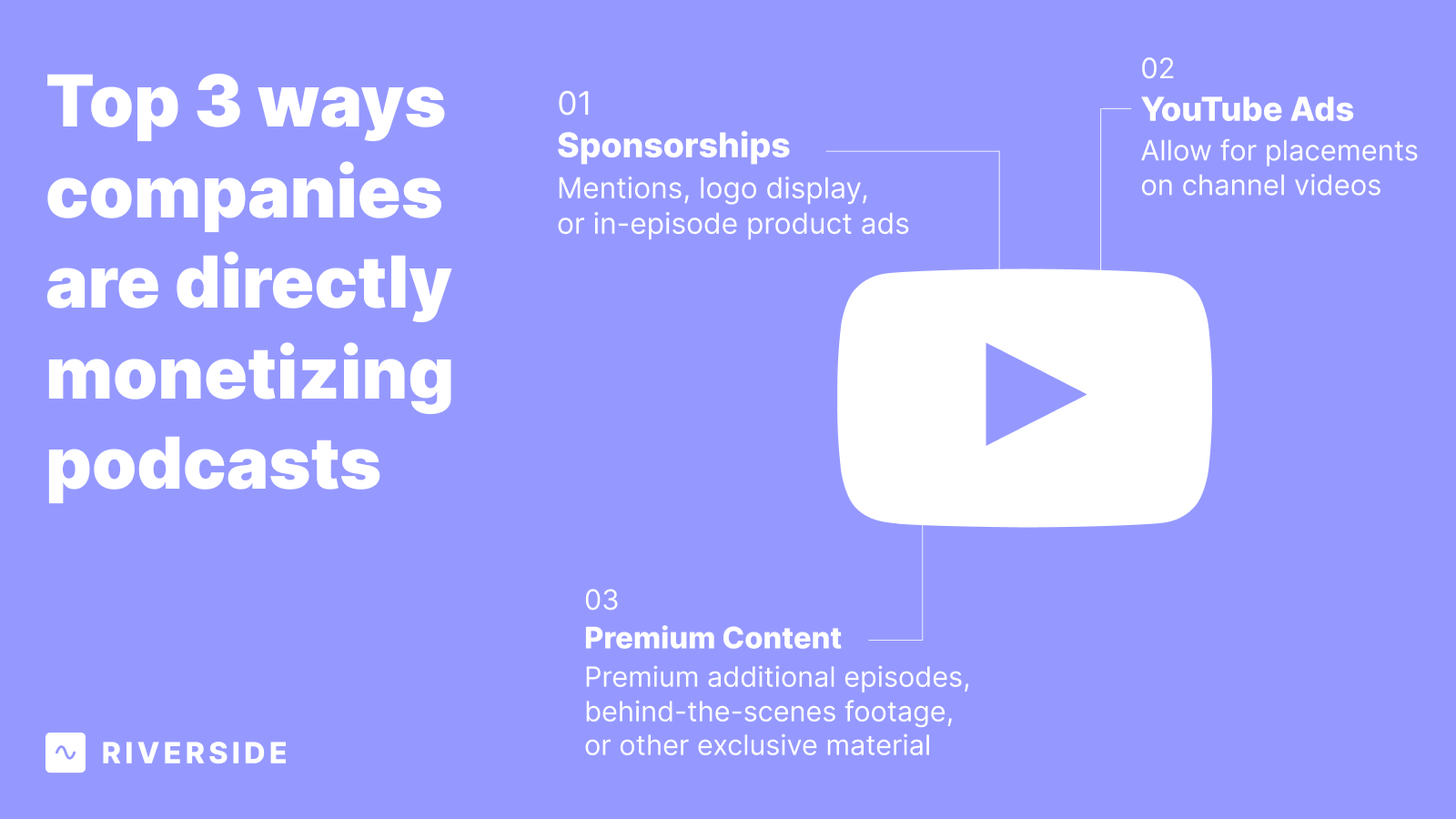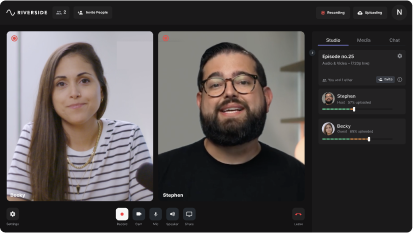
With video podcasting’s momentous rise in popularity, Riverside’s Annual Report dives deeper into this impactful medium. As the 8th of an 11-part series, this article looks at companies’ monetization strategies around video podcasts.
What’s in it for me?
By the end of this section, you’ll have key insights on the following points:
- How companies are using premium content to monetize video podcasts
- How companies are using sponsorships to monetize video podcasts
- How companies are using advertising to monetize video podcasts
Overview of Video Podcast Monetization
The majority of company video podcasts are not yet monetizing their show. In fact, our survey unveiled that only 35% of companies are building their podcast with the goal of monetizing.
That leaves a massive opportunity for brands who are able and willing to begin monetizing their company show.
Of the brands that are monetizing, the average monthly revenue from a company podcast currently is under $1000.
In this section, we’ll dive into 3 proven tactics companies are currently using to monetize successfully.

Premium Content
Premium content is content that is only available to paying subscribers or members.
By offering premium content, video podcasts can provide additional value to subscribers and give them a reason to continue supporting the show.
What are the different types of premium content companies are offering?
This content could take the form of additional episodes, behind-the-scenes footage, or other exclusive material that is not available to the general public.
It can be offered as part of a subscription model, giving subscribers access to all of the podcast's premium content for a monthly or yearly fee. This can be a great way to monetize the podcast and provide a steady revenue stream.
How lucrative can premium content be?
Our survey reported that 29% of monetized brand shows use premium content to drive revenue.
What is the difficulty level for setting this up for your podcast?
The difficulty of creating premium content for a video podcast will vary depending on the specific content being created and the resources available to the team.
In general, creating premium content will require additional planning and production compared to regular podcast episodes. This can include securing special guests for interviews, organizing in-depth discussions on specific topics, or planning live Q&A sessions with the audience.
The level of difficulty for this effort is high in the beginning, but gets more manageable as you develop systems for creating the exclusive content.
Sponsorships
Sponsorships for video podcasts are partnerships between the podcast and another brand.
In a sponsorship arrangement, the brand or company provides financial support to the podcast in exchange for promotional opportunities and advertising.
This can include mentions, logo display, or in-episode product ads.
What are the different ways companies can approach sponsorships?
This tends to be a straightforward engagement, but there are multiple ways to approach sponsorships with another brand or influencer.
Here are a few:
- Mentioning the brand or company during the podcast
- Displaying the brand's logo on the podcast's website or social media
- Incorporating the brand's products into the podcast's content
- Offering exclusive discounts or promotions to the podcast's audience
- Providing a sponsored segment or episode focused on the brand's products or services
- Offering sponsored giveaways or contests to the podcast's audience
- Collaborating with the brand on co-branded content or events
How lucrative can sponsorships be?
Our survey reported that 34% of monetized brand shows are using sponsorships to drive revenue.
What is the difficulty level for setting this up for your podcast?
In general, podcasts with a large and engaged audience are more likely to attract sponsorships from other brands easily.
They can leverage their audience to provide valuable exposure and reach for the sponsoring brand, making them an appealing partnership.
Setting up the structure for sponsorships can take some time. This can include creating a proposal that outlines the benefits of partnering with the podcast, negotiating the terms of the sponsorship, and fulfilling any promotional or advertising obligations.
Overall, the level of difficulty for this effort is medium. Most of the challenges lie in finding the right people or companies to connect with, successfully getting in touch with them, and negotiating. Beyond that, the effort becomes low.
YouTube Ads
Most of us know this one well already, but here’s a quick overview just in case. YouTube Ads come in the form of video ads, display ads, or sponsored content.
They are shown to users who are watching YouTube videos or browsing the platform and are typically targeted based on the user's interests and demographic information.
What are the different ways companies can approach YouTube Ads?
Unlike other methods, there’s only one place and one way to monetize through this channel: to run ads on YouTube.
There are, however, a couple of different ad formats that can be used to diversify the approach.
You can add a blurb to videos you post on your own channel. This is the quickest way to start advertising your show more if you have other content for the company on YouTube.
You can run targeted ads that show before (or during) other channels’ videos. This is the most common iteration you’ll see, and can be highly effective.
How lucrative can YouTube Ads be?
Our survey reported that 71% of monetized brand shows use YouTube ads to drive revenue.
What is the difficulty level for setting this up for your podcast?
Of all these methods, this is the easiest to set up. The only requirement is that your content meets YouTube’s advertiser-friendly content guidelines. If there are no issues there, you can turn on ads in the Monetization tab of your YouTube dashboard.
Beyond that key step, you simply need to set up the ads to run and allocate a budget. This will likely be costlier than other methods depending on how aggressive you are with ad spend.
Read more from the 2023 Riverside Annual Report series:
- Why has video podcasting become increasingly popular
- What are the major benefits of a video-first podcast compared to a standard show
- How video podcasting has changed in the past several years
- How different audiences are responding to video podcasts
- Who benefits the most from a rise in video podcasting
- How companies are recording video podcasts
- How companies are growing their video podcast’s audience















.png)
.png)
.png)
 (1).webp)
.webp)
.webp)








